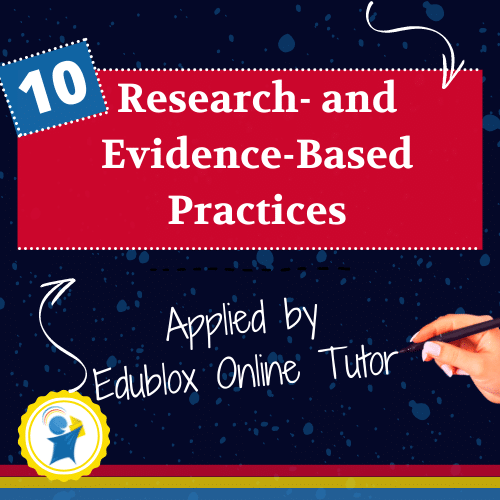
Edublox Online Tutor is an online platform that houses a range of products and services to improve various aspects of learning. Our programs include Development Tutor, Reading Tutor, and Live Tutor. Live Tutor is our flagship and offers four programs that target five academic areas:
- Reading and spelling,
- Spelling and writing;
- Reading comprehension; and
- Numeracy
.
These tailor-made sessions are offered in conjunction with Development Tutor and recommended for students with mild to severe learning disabilities, including dyslexia, dysgraphia, dyscalculia (math learning disabilities), and poor reading comprehension.
Edublox’s Live Tutor is aligned with research-based and evidence-based reading practices recommended by the National Reading Panel (NRP) in 2000 and essential research studies. Therefore, although we focus on reading in this article, Edublox’s numeracy program is based on the same principles.
(1.) Neuroplasticity at the heart
People were convinced that, once we grow up, our brains have a set number of neurons performing functions in a fixed way. In the past two decades, however, neuroscientists have dismantled, piece by piece, the entrenched view that the human brain is fixed and unchanging.
A growing number of research publications have illustrated the brain’s ability to modify, change, and adapt both structure and function throughout life and in response to experience. Changes associated with learning usually occur in the connections between neurons: new connections can form, and the internal structure of the existing synapses can change. New neurons are constantly being born, particularly in the learning and memory centers. When one becomes an expert in a specific domain, the areas in the brain that deal with this skill will grow.
Named neuroplasticity, the brain’s ability to change is at the heart of Edublox practices.
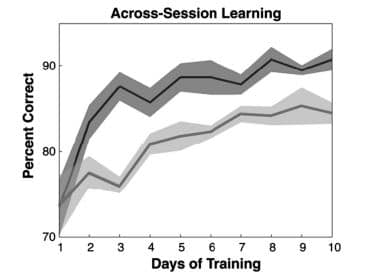
improvement in learning when multisensory learning (darker curve) is used instead of unisensory learning (lighter curve).
(2.) Edublox programs are multisensory
Multisensory training refers to the use of visual, auditory, and kinesthetic-tactile pathways simultaneously to enhance learning.
Educators and clinicians have long believed that multisensory training can enhance learning. For example, in 1967, Treichler stated: “People generally remember 10% of what they read, 20% of what they hear, 30% of what they see, and 50% of what they see and hear.”
Memory research showed that multisensory exposure could result in superior recall compared to unisensory exposure (Shams & Seitz, 2008). Rao (2017) concluded that using multiple channels accelerates learning and memory by up to 80%.
(3.) Edublox targets phonological awareness
Since the beginning of the twentieth century, dyslexia research has been dominated by a search for the Holy Grail: the single cognitive deficit that is necessary and sufficient to cause all behavioral characteristics of dyslexia. Until the 1950s, the belief was that dyslexia is attributable to visual processing problems. Visual processing refers to the brain’s ability to make sense of what the eyes see.
In 1957 Noam Chomsky published his seminal book, Syntactic Structures, which transformed the study of language and, with it, reading. Any role for visual processing was abandoned, and dyslexia became a linguistic problem — specifically, a deficiency in phonological awareness.
Phonological awareness is hearing and identifying the various sounds in spoken words. Phonemic awareness is a subset of phonological awareness that focuses on recognizing and manipulating phonemes, the smallest sound units. The two most crucial phonemic awareness skills are segmenting and blending.
(4.) Edublox targets multiple cognitive skills
Phonological and phonemic awareness is critical for developing reading skills, decoding, and fluency (NRP, 2000). Interventions based on the phonological deficit theory alone, however, have proved to be ineffective (Nicolson & Fawcett, 2018). The reason is that other cognitive skills that are equally important were overlooked at the time.
Current thinking sees phonological deficits as one of the multiple deficits likely to interact to cause reading disability (Peterson & Pennington, 2012; Pennington, 2006). In addition to phonological awareness, cognitive psychology has now linked many brain-based skills to dyslexia:
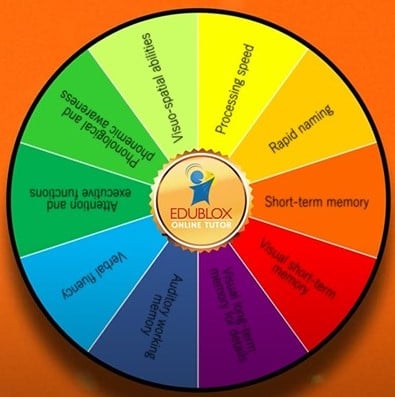
- verbal fluency (Moura et al., 2015);
- attention and executive functions (Menghini et al., 2010);
- visual attention, i.e., our ability to rapidly select the most relevant visual information ranges when we are engaged in various reading tasks (Elliott, 2015; Valdois et al., 2004);
- visuospatial abilities (Giovagnoli et al., 2016; Menghini et al., 2010; Helland & AsbjØrnsen, 2003);
- processing speed (Moura et al., 2015; Stoodley & Stein, 2006);
- short-term memory (Cowan et al., 2017; Majerus & Cowan, 2016);
- auditory working memory (Vender, 2017; Weiss et al., 2014);
- visual and visual sequential memory (Talepasand et al., 2018; Guthrie & Goldberg, 1972);
- visual long-term memory (Binamé et al., 2015), especially for details (Huestegge et al., 2014);
- verbal long-term memory (Helland & Morken, 2015); and
- rapid naming (Brizzolara, 2006; Denckla & Rudel, 1976).
.
Edublox, therefore, targets multiple cognitive skills.
Like reading, math is also underpinned by multiple cognitive skills, including visual and auditory processing; visual, visuospatial, and working memory; and logical reasoning (Mercer, 1997; Kulp et al., 2004; Szűcs et al., 2013; Price & Ansari, 2013). Edublox’s Development Tutor also targets these cognitive skills.
(5.) Edublox is explicit and systematic
Since its inception many decades ago, Edublox insisted that there is nothing that any human being knows, or can do, that they have not learned. We also asserted that human learning does not take place on a single level but is a stratified process. Scientific research reviewed by the National Reading Panel has confirmed this: systematic and explicit instruction is the most effective approach to teaching reading.
Explicit teaching practices involve showing students what to do and how to do it. Strategies emphasizing silent and independent reading have not been proven to improve reading achievement (NRP, 2000; Carver & Liebert, 1995).
Systematic teaching means skills and concepts are taught in a planned, logically progressive sequence. For example, certain sounds — those that are easier to learn or used more often — are taught before other sounds.
In math, one has to learn to count before it becomes possible to learn to add and subtract. Suppose one tried to teach a child who had not yet learned to count to add and subtract. This would be quite impossible, and no amount of effort would ever succeed in teaching the child to add and subtract. This shows that counting is a skill that needs to be mastered before it becomes possible to learn to do calculations.
(6.) Edublox is phonics-based
The National Reading Panel concluded that various types of systematic phonics approaches are significantly more effective than non-phonics approaches in promoting substantial growth in reading (NRP, 2000).
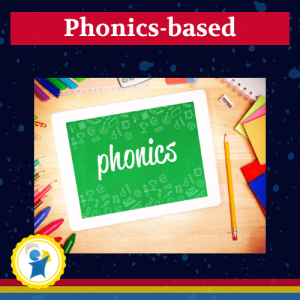
Phonics is a set of rules that specify the relationship between letters in the spelling of words and the sounds of spoken language. For the English language, these relationships are predictable but not wholly consistent. However, they are consistent enough to be very useful to children in helping them learn to decode unfamiliar words.
At Edublox, phonograms are taught in isolation with adequate repetition and intervals between each phonogram for complete mastery. Integration with previous lessons, and frequent review, are considered crucial. Reading and spelling — which include spelling rules — are taught simultaneously.
(7.) Edublox builds fluency
Fluent readers can read text with speed, accuracy, and proper expression. It is generally acknowledged that fluency is a critical component of skilled reading and that there is a close relationship between fluency and reading comprehension. Students with low fluency may have difficulty understanding what they read (NRP, 2000).
Research shows that a network of brain regions is involved in learning to read, one specifically in sounding out words and another in seeing words as pictures. The left inferior parietal lobule is said to be involved in word analysis, grapheme-to-phoneme conversion, and general phonological and semantic processing. The picture area is located in the left occipitotemporal region and is known as the visual word form area (VWFA) or visual dictionary. Neuroscientists at Georgetown University Medical Center concluded that skilled readers could recognize words at lightning-fast speed when they read because they have been placed in the VWFA or visual dictionary (Glezer et al., 2016).
In the largest study of its kind up to date, Brem et al. (2020) confirmed that the VWFA is key to fluent reading using fMRI data (n = 140 children, 7.9–12.2 years; 55 children with dyslexia, 73 typical readers, 12 intermediate readers). Their study also showed that connectivity of the left occipitotemporal cortex seems a prerequisite for guiding the emerging specialization in the VWFA.
Logan (1997) reports that automatic word recognition can be thought of as a continuum that begins with a beginning reader’s slow, struggling word recognition and extends to the skilled reader’s rapid, effortless word recognition.
Fluency is first developed through systematic phonics (see no. 7 above), but fluency also involves grouping words into meaningful phrases and reading with expression. Two forms that have shown evidence of improving fluency, ensuring that words are placed in the VWFA, are repeated reading and guided repeated oral reading (NRP, 2000). Both are applied in Edublox tutoring.
(8.) Edublox expands vocabulary
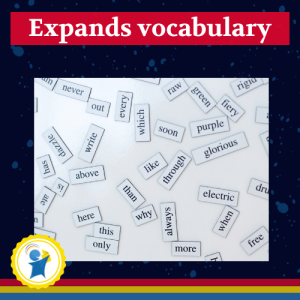
The National Reading Panel defines vocabulary as understanding individual word meanings in a text. The importance of vocabulary in reading achievement has been recognized for over half a century. As early as 1925, in the National Society for Studies in Education (NSSE) Yearbook, this quotation appears:
Growth in reading power means … continuous enriching and enlarging of the reading vocabulary and increasing clarity of discrimination in appreciation of word values (Whipple, 1925, p. 76).
Researchers distinguish between many different “vocabularies.” Receptive vocabulary is the vocabulary we can understand when presented in text or when listening to others speak. In contrast, productive vocabulary is the vocabulary in writing or when speaking to others. It is generally believed that receptive vocabulary is much larger than productive vocabulary since we often recognize words we rarely use.
Vocabulary is also sub-categorized as oral vs. reading vocabulary. Oral refers to words recognized in speaking or listening, while reading vocabulary refers to words used or recognized in print (NRP, 2000).
Edublox Live Tutor uses explicit instruction to expand vocabulary. However, if a child has severe vocabulary and language delays, we recommend a passive, at-home method based on the Suzuki violin teaching methodology that delivers excellent results (Akdeniz, 2015).
Mathematics is associated with numbers and symbols. But, it is also associated with intriguing words and its own vocabulary. Everyday words have different meanings in a mathematical context. For example, words like “difference,” “true,” or “product” can have different definitions or connotations in our everyday life. Edublox’s numeracy program aims at teaching math terminology, including the appropriate meaning of words when in the context of a math problem.
(9.) Edublox develops comprehension
Comprehension is critical in developing children’s reading skills and, therefore, their ability to obtain an education. Indeed, reading comprehension has become the “essence of reading” (Durkin, 1993), essential to academic and lifelong learning.
A child can read fluently but without comprehension. Neuro-imaging of children showed that, while reading, the brain function of those with reading comprehension problems is quite different and distinct from those with reading disabilities. Those with reading disabilities exhibited abnormalities in a specific region in the left occipitotemporal region (see no. 8 above). On the other hand, those with reading comprehension problems did not show abnormalities in this region. Instead, they showed specific abnormalities in regions typically associated with memory (Cutting et al., 2013).
Other reasons for fluent reading without comprehension may be poor vocabulary and weak logical reasoning skills. The relationship between logical reasoning and reading comprehension is well-established in the literature. It has been said that “there is no reading without reasoning,” and even that reading is reasoning.
In addition to improving vocabulary, memory, and reasoning skills, Edublox students are taught to find the main idea(s) in texts; distinguish between cause and effect; differentiate between fact and opinion; draw conclusions and make inferences.
(10.) Repetition is not the enemy
As far as one can go back in history, repetition (also known as drill-and-practice) has been considered the backbone of successful teaching and schooling. However, in the 1920s and 1930s, repetition and rote learning came to define poor teaching. Good teachers refrain from firing off quiz questions and catechize kids about facts. They do not drill students on spelling or arithmetic.
When properly conducted, however, drill-and-practice is a consistently effective teaching method and should not be slighted as “low level,” and appears to be just as essential to complex and creative intellectual performance as they are to the performance of a virtuoso violinist (Brophy, 1986). Christodoulou (2014) argues that memorizing does not prevent understanding but is vital to it. The very processes teachers care about most, says Willingham (2009) — critical thinking processes such as reasoning and problem-solving — are intimately intertwined with factual knowledge stored in long-term memory. Knowledge ready in long-term memory is often required as a stepping-stone to understanding something deeper.
Whatever the case for the average student, repetition certainly benefits children with learning challenges. For example, a meta-analysis of 85 academic intervention studies with students with learning disabilities found that regardless of the practical or theoretical orientation of the study, the largest effect sizes were obtained by interventions that included systematic drill, repetition, practice, and review (Swanson & Sachse-Lee, 2000).
From a neuroscientific perspective, repetition is essential in the “wiring” of a person’s brain, i.e., forming connections or synapses between the brain cells. Without repetition, key synapses do not form. Moreover, if such connections, once formed, are used too seldom to be strengthened and reinforced, the brain, figuring they are dead weight, eventually “prunes” them away (Hammond, 2015; Bernard, 2010).
Edublox offers live online tutoring to students with dyslexia and other learning disabilities. Our students are in the United States, Canada, Australia, and elsewhere. Book a free consultation to discuss your child’s learning needs.
.
References:
Akdeniz, H. B. (2015). A comparison of the main features of Suzuki and traditional violin education. Journal of Literature and Art Studies, 5(2), 107-113.
Bernard, S. (2010). Neuroplasticity: Learning physically changes the brain. Edutopia.
Binamé, F., Danzio, S., & Poncelet, M. (2015). Relative ease in creating detailed orthographic representations contrasted with severe difficulties to maintain them in long-term memory among dyslexic children. Dyslexia, 21(4), 361-370.
Brem, S., Maurer, U., Kronbichler, M. et al. (2020). Visual word form processing deficits driven by severity of reading impairments in children with developmental dyslexia. Scientific Reports, 10.
Brizzolara, D., Chilosi, A., Cipriani, P., Di Filippo, G., Gasperini, F., Mazzotti, S., … Zoccolotti, P. (2006). Do phonologic and rapid automatized naming deficits differentially affect dyslexic children with and without a history of language delay? A study of Italian dyslexic children. Cognitive and Behavioral Neurology, 19(3), 141-149.
Brophy, J. (1986). Teacher influences on student achievement. American Psychologist, 41, 1069–1077.
Carver, R., & Liebert, R. (1995). The effect of reading library books in different levels of difficulty on gains in reading ability. Reading Research Quarterly, 30(1), 26–48.
Christodoulou, D. (2014). Seven myths about education. London: Routledge.
Cowan, N., Hogan, T. P., Alt, M., Green, S., Cabbage, K. L., Brinkley, S., & Gray, S. (2017). Short‐term memory in childhood dyslexia: Deficient serial order in multiple modalities. Dyslexia, 23, 209-233.
Cutting, L. E., Clements-Stephens, A., Pugh, K. R., Burns, S., Cao, A., Pekar, J. J., Davis, N., & Rimrodt, S. L. (2013). Not all reading disabilities are dyslexia: Distinct neurobiology of specific comprehension deficits. Brain Connectivity, 3(2), 199–211.
Denckla, M. B., & Rudel, R. G. (1976). Rapid ‘automatized’ naming (R.A.N.). Dyslexia differentiated from other learning disabilities. Neuropsychologia, 14, 471-479.
Durkin, D. (1993). Teaching them to read. (6th ed.) Boston, MA: Allyn and Bacon.
Elliott, J. G. (2015). The dyslexia debate: Actions, reactions, and over-reactions. Psychology of Education Review, 39(1), 6-16.
Giovagnoli, G., Vicari, S., Tomassetti, S., & Menghini, D. (2016, 21 December). The role of visual-spatial abilities in dyslexia: Age differences in children’s reading? Frontiers in Psychology.
Glezer, L. S., Eden, G, Jiang, X., Luetje, M., Napoliello, E., Kim, J., & Riesenhuber, M. (2016). Uncovering phonological and orthographic selectivity across the reading network using fMRI-RA. Neuroimage, 138, 248-256.
Guthrie, J. T., & Goldberg, H. K. (1972). Visual sequential memory in reading disability. Journal of Learning Disabilities, 5(1), 45-50.
Hammond, Z. (2015). Culturally responsive teaching and the brain. Thousand Oaks, CA: Corwin.
Helland, T., & AsbjØrnsen, A. (2003). Visual-sequential and visuo-spatial skills in dyslexia: Variations according to language comprehension and mathematics skills. Child Neuropsychology 9(3), 208-220.
Helland, T., & Morken, F. (2015). Neurocognitive development and predictors of l1 and l2 literacy skills in dyslexia: A longitudinal study of children 5-11 years old. Dyslexia, 22(1), 3-26.
Huestegge, L., Rohrßen, J., van Ermingen-Marbach, M., Pape-Neumann, J., & Heim, S. (2014). Devil in the details? Developmental dyslexia and visual long-term memory for details. Frontiers in Psychology.
Kulp, M. T. et al. (2004). Are visual perceptual skills related to mathematics ability in second through sixth grade children? Focus on Learning Problems in Mathematics, 26(4), 44-51.
Logan, G. (1997). Automaticity and reading: Perspectives from the instance theory of automatization. Reading and Writing Quarterly, 13(2), 123–146.
Majerus, S., & Cowan, N. (2016). The nature of verbal short-term impairment in dyslexia: The importance of serial order. Frontiers in Psychology.
Menghini, D., Finzi, A., Benassi, M., Bolzani, R., Facoetti, A., Giovagnoli, S., … Vicari, S. (2010). Different underlying neurocognitive deficits in developmental dyslexia: A comparative study. Neuropsychologia, 48(4), 863-872.
Mercer, C. D. (1997). Students with learning disabilities, 5th ed. Upper Saddle River, NJ: Merrill.
Moura, O., Simões, M. R., & Pereira, M. (2015). Executive functioning in children with developmental dyslexia. The Clinical Neuropsychologist, 28(S1), 20-41.
National Reading Panel (U.S.) & National Institute of Child Health and Human Development (U.S.). (2000). Report of the National Reading Panel: Teaching children to read: An evidence-based assessment of the scientific research literature on reading and its implications for reading instruction. U.S. Dept. of Health and Human Services, Public Health Service, National Institutes of Health, National Institute of Child Health and Human Development.
Nicolson, R. I., & Fawcett, A. J. (2018). Procedural learning, dyslexia and delayed neural commitment. In T. Lachmann & T. Weis (Eds.). Reading and dyslexia (pp. 229-57). Cham, Switzerland: Springer.
Pennington, B. F. (2006). From single to multiple deficit models of developmental disorders. Cognition, 101(2): 385-413.
Peterson, R. L., & Pennington, B. F. (2012). Developmental dyslexia. The Lancet, 379, 1997–2007.
Price, G., & Ansari, D. (2013). Dyscalculia: Characteristics, causes, and treatments. Numeracy, 6(1).
Rao, A. R. (2018). An oscillatory neural network model that demonstrates the benefits of multisensory learning. Cognitive Neurodynamics, 12, 481–499.
Seitz, A. R., Kim, R., & Shams, L. (2006). Sound facilitates visual learning. Current Biology, 16(14), 1422–1427.
Shams, L., & Seitz, A. R. (2008). Benefits of multisensory learning. Trends in Cognitive Sciences, 12(11), 411–417.
Stoodley, C. J., & Stein, J. F. (2006). A processing speed deficit in dyslexic adults? Evidence from a peg-moving task. Neuroscience Letters, 399(3), 264-267.
Swanson, H. L., & Sachse-Lee, C. (2000). A meta-analysis of single-subject design intervention research for students with LD. Journal of Learning Disabilities, 38(2), 114-136.
Szűcs, D., Devine, A., Soltesz, F., Nobes, A., & Gabriel, F. (2013). Developmental dyscalculia is related to visuo-spatial memory and inhibition impairment. Cortex, 49(10), 2674-2688.
Talepasand, S., Eskandaripour, M., & Taghinezhad, A. (2018). Comparison of working and visual memory in children with and without dyslexia. Zahedan Journal of Research in Medical Sciences, 20(9).
Treichler, D. G. (1967). Are you missing the boat in training aid? Film and Audio-Visual Communication, 1, 14–16.
Valdois, S., Bosse, M.-L., & Tainturier, M.-J. (2004). The cognitive deficits responsible for developmental dyslexia: Review of evidence for a visual attentional deficit hypothesis. Dyslexia, 10(4), 339-363.
Vender, M. (2017). Disentangling dyslexia. Bern: Peter Lang AG.
Weiss, A. H, Granot, R. Y., & Ahissar, M. (2014). The enigma of dyslexic musicians. Neuropsychologia, 54, 28-40.
Whipple, G. (Ed.). (1925). The twenty-fourth yearbook of the National Society for the Study of Education: Report of the National Committee on reading. Bloomington, IL: Public School Publishing Company.
Willingham, D. T. (2009). Why don’t students like school? San Francisco, CA: Jossey-Bass.

